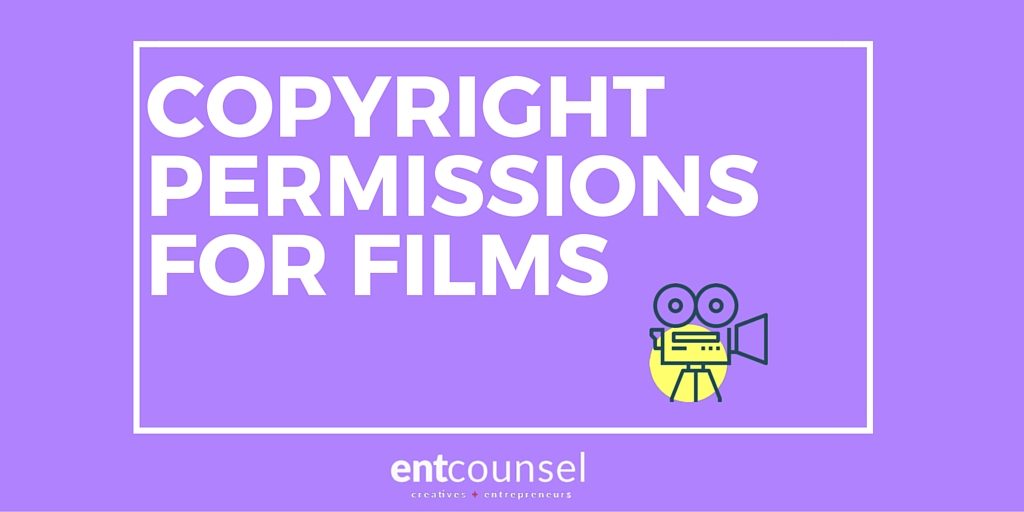Obtaining copyright clearance and permissions for film producers is imperative. The purpose of retaining the services of a lawyer is to ensure that you obtain all the rights you need from the “key agreements” to ensure logical integration of these with all other aspects of your production (such as financing, distribution, meeting Canadian content requirements and tax credits, etc.). You want to ensure that you are protecting the profitability of the production.
Copyright Clearance Procedure
Before starting with copyright clearance, first look at the structure of the production company and decide whether it will be organized as a sole proprietor, partnership or corporation (in this instance, the production company must be Canadian controlled from the outset). A production company must then look at meeting “Canadian” requirements. Meeting Canadian requirements will get a production certified by CAVCO as a Canadian production. If a production is considered “Canadian”, the better chance of a broadcaster picking it up. There is a six-point test (read v. below).
Once you get the preliminary requirements in setting up a production company, you can then look at ensuring you have a procedure for copyright clearance in place. This article will help you navigate the complicated world of film copyright clearances and help you know where to start.
Copyright Clearance & Permissions for Film
Quotations
- If you are using film and television footage, quotations, photographs, artwork. generally speaking, you will need to get obtain copyright permission from the copyright owner
Public Domain
- However, you won’t need permission if the work is in the public domain or falls under a copyright exception
- Public domain – the general rule is life of author plus 50 years and copyright expires and falls into the public domain
Facts and Ideas
- No copyright in facts or ideas (news, weather)
- Two productions can have the same idea but each is protected by copyright (eg. Idea for a wedding show).
- Moral rights
Adaptations
-
There is new copyright attached to the work if you edit, adapt, translate a substantial portion of it
Fair Dealing exceptions when Copyright Clearance Is Not Required
- In order to use the fair dealing defence, you will need to successfully argue that the purpose of your use if for new reporting, criticism or review and you must provide a credit in all instances
- Provide a credit to the copyright owner. Credit includes the name of movie/tv footage, copyright holder (FOX, Paramount), year work was published
- Only use enough of the material to illustrate your point
- Courts interpret this defence restrictively
- A court looks at factors such as the amount and significance of the work copied, the use made of the copy, the degree to which the copy competes with the original and availability of a license from a collective society).
- For instance, if you are critiquing a movie or a particular piece of music in a news show, then you can argue this defence. However, if you are just using the music as background to your news story but has nothing to do with the story, then you would need to obtain permission
- Otherwise, you should ensure that you have written agreements in place with all creators, authors, writers and owners of all materials you have used in your production providing you with permission to use the materials
- The general rule is that anything that may be protected by copyright or trade-mark or that may be a basis for a claim of privacy must be cleared if the materials are shown on film.
- Searching for copyright owners
- Read more about fair dealing.
Clearing title of the production and obtaining copyright permission
- Ensure that the name of your production does not infringe the rights of any other production
- You may need to get a trade-mark search taken and get a title search opinion (will you will usually need for your insurer).
- Make sure you are not naming your show something that is a take-off from another show (eg. “Survival of the Fittest” or “Toronto Idol”)
Location/site release
- obtain a release from the owner of the property to provide you with copyright permission and permit you to film your story there
- to ensure you are allowed to bring personnel and equipment, props, and sets onto the site
- malls, cities, parks, street permits
Underlying script
- If the script or literary rights you are using are not your own original work and you are using someone else story or script, then you will need to get copyright permission from them
Film and television footage clearance
- Clearance is required from both the copyright holder (such as the studio) and the actor
- Chris Isaak footage example (required clearance from both management and studio)
- The footage license agreement should have an outline of:
- The rights being granted
- In what forms of media will it be used in (tv, internet, DVD rights)
- Term, territory, license fee
- Who is responsible for clearances in the footage (actors, music, synchs etc.)
- Who retains copyright in the footage
- Obtain reps and warranties from licensor of footage
- They have the rights to the footage (including all rights from all actors, musicians, models or others appearing in the footage).
- The footage is original
- It does not infringe the rights of any third party
- Get an indemnity from the licensor
Music rights clearances
- Write your own original music or use preexisting music (depends on your budget)
- Different types of rights in music (synch, public performance, master use) and therefore, a multitude of rightsholders. (songwriter, composer, lyricist, performer, publisher, record company) – need to get permission from all these stakeholders
- Synch rights – allows the producer of a film, television show to incorporate a musical work and allowing them so synchronize music with the visual elements
- Master use license – allows a producer to use and reproduce a particular sound recording of a musical work in a motion picture or tv show
- Public performance licenses – the right to perform music in public such as radio stations, tv shows, clubs, concerts etc…
- Each time music is played, payment is made to the composer, lyricists, songwriters and their publishers)
- note that if a broadcaster is purchasing your production, then more than likely they already have a performance license in place).
- All music whether hummed or whistled must be cleared
- Mistaken assumption that you can use 30 secs (music is different..generally if its recognizable, get clearance).. record industry and music publishers are more vigilante
- Music Videos
- Audio Visual Licensing Agency (AVLA) reps most major artists
- If broadcaster involved, then they probably already have a license with the AVLA
- If using a music video, you will need to provide a credit while video is playing that would include: 1) name of song; 2) name of the artist or group; and 3) the record label.
- Music lifted from a CD
- Master use license from master recording owner (usually the record label) and a synchronization license
- Performers/live bands
- More complicated – many parties involved
- 1) Performance agreement with band’s manager and record labels
- 2) Synchronization agreement with music publishers
- If more than one writer to a particular song, then this process could get complicated and could be entering into different synch license agreement with various music publishers eg. A song could have 5 writers administered by 3 different publishers
- Can be expensive and takes a long time to clear esp is using a popular cover song
- 3) AF of M
- 4) Public performance – need to file cue sheets because have to pay SOCAN
- Parody – no exception in Canada and so must get clearance
- Changing lyrics (is it substantial enough)
- DJ’s
- Sample and use various music and will need to clear every one of those songs
- Can decide who pays for synchs
- Music libraries – general music – cheaper and easier and faster (network music, firstcom music, OGM Production music, Associated Production Music and Killer Tracks)
Releases
- Written releases must be obtained from all individuals are recognizable in the production or whose name, image or likeness is used
- Minors – If the individual is minor, the release must be legally binding and must have parental consent (parents sign release)
- Deceased – If the recognizable or identifiable person is deceased, then you must obtain a release from the personal representative of that person
- Background shots – Releases are not necessary if the recognizable person is part of a crowd or background short and his/her image is not shown for more than a few seconds of given special emphasis (ie. But make sure they are not being associated with any defamatory remarks).
- MMVA’s have a general sign when people enter that they will be taped etc…
- Celebrities – A celebrity has the right to control the use of his/her name of likeness for commercial purposes
- For celebrities, make sure you get permission for the right to use their image from their agent and manager. You may also need to contact a film studio who owns the footage showing the celebrity because they are the ones that actually own the footage
Trade-mark issues
- if you are filming scenes that depict any brands, logos, products of other companies, make sure you get clearance
- Releases are not necessary if the property is non-distinctive background only
- Examples:
- Molson beer bottle, coke cans
- Citytv logo sign (on signs and microphones)
- Designer clothes
- Storefronts
- Advertisements
- Names of musical bands
Character clearances
- all characters based partially or wholly on real people (living or dead) must be cleared
- all fictional character names in your story should be checked with the names of real people living in the same area or having the same occupation to ensure a real person has not been used
- You do not need to clear first names if not an identifiable name (eg. Madonna).
- Dressing up as a celebrity like Mickey Mouse or Britney Spears
Photographs
- for photographs, if actual people, places or object (include clearance from the copyright holder, the photographer/artist and any other recognizable person in the photograph, models
Artwork, books, magazines, newspapers
- artwork includes drawings, paintings, murals, sculptures, posters, calendars, record covers
- image banks
You may be interested in this article which describes the process and sample language for obtaining copyright clearance and permission from a copyright owner.



